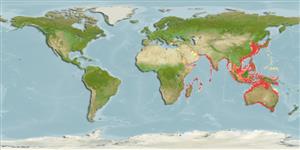Common names from other countries
Classification / Names / Names
Common names | Synonyms | Catalog of Fishes (gen., sp.) | ITIS | CoL | WoRMS
Environment: milieu / climate zone / depth range / distribution range
Ecology
Benthic; depth range 13 - 300 m (Ref. 8), usually ? - 60 m (Ref. 801). Tropical, preferred 27°C (Ref. 107945); 41°N - 45°S, 25°E - 154°E
Indo-West Pacific and the Mediterranean.
Length at first maturity / Size / Weight / Age
Maturity: Lm 1.7, range 2 - ? cm Max length : 2.2 cm CL male/unsexed; (Ref. 8); 3 cm CL (female); max. reported age: 1.25 years (Ref. 117187)
Maximum depth from Ref. 801.
Members of the order Decapoda are mostly gonochoric. Mating behavior: Precopulatory courtship ritual is common (through olfactory and tactile cues); usually indirect sperm transfer.
Holthuis, L.B. 1980. (Ref. 8)
IUCN Red List Status (Ref. 130435: Version 2024-1)
CITES status (Ref. 108899)
Not Evaluated
Not Evaluated
Human uses
Fisheries: minor commercial
FAO - Fisheries: landings, species profile | FishSource | Sea Around Us
Tools
Internet sources
Estimates based on models
Preferred temperature
(Ref.
115969): 18 - 28.2, mean 27.1 (based on 356 cells).
Resilience
High, minimum population doubling time less than 15 months (K=0.92-2.76; tm=0.49; tmax=1.25).
Prior r = 1.19, 95% CL = 0.79 - 1.79, Based on 2 data-limited stock assessments.
Vulnerability
Low vulnerability (10 of 100).
